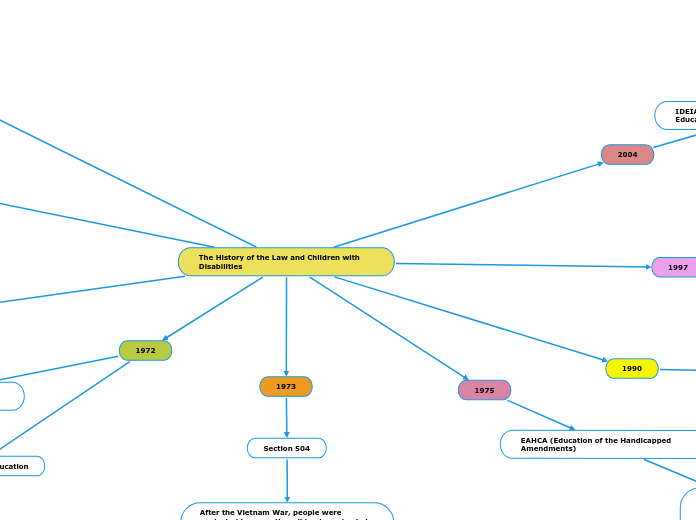The History of the Law and Children with Disabilities
1972
PARC (Pennsylvania Association for Retarded Children vs. Pennsylvania)
The suit named the state's secretary of Education and Public Welfare, the state Board of Education, and 13 school districts. It permitted the schools to deny education to children who do not reach the mental age of five or the average intellectual of people aged five before they begin first grade.
Mills vs. Board of Education
Parents of seven children filed a suit because their children did not have access to public education. Students with disabilities are entitled to an education, which cannot be denied based on the accommodations' added cost of the school.
1973
Section 504
After the Vietnam War, people were neglected because they did not receive help and benefits. Then, because of that, Section 504 was created to ensure that a child with a disability will have access to a learning environment. From K-12 grade levels.
2004
IDEIA (Individuals with Disabilities Education Improvement Act)
President Bush signed the IDEIA. There were changes in the IEPs, discipline, and identification of students with learning disabilities. Also, that teacher should be qualified and certified to give an education.
1997
IDEA (Individuals with Disabilities Education Act Amendments)
The law provided access to children with special needs and access to the general curriculum to provide equality in education.
1990
IDEA (Individuals with Disabilities Education Act)
EAHCA was then named IDEA. There were a lot regulations to the law. It provided the individualized education programs (IEP) of students with disability who were 16 or older. Brain injury and Austin were added to the disability categories.
1975
EAHCA (Education of the Handicapped Amendments)
At the beginning, parents received services Parents then received services from the moment their children were born through age 2, by using early interventions. Then the, Part B of the program was extended to 3 to 5 years old.
1970
The Education of the Handicapped Act
Guarantee the FAPE (Free Appropriate Public Education) to the students with special needs in order to progress in their learning.
1954
Brown vs. Board of Education
It was Case-based, particularly on African Americans' civil rights and equality of opportunity. It leads to creating regulations in education and eventually for individuals with disabilities.
1910
The White House Conference
Children with special needs were moved from institutions to public schools since it was stated that they could learn.
